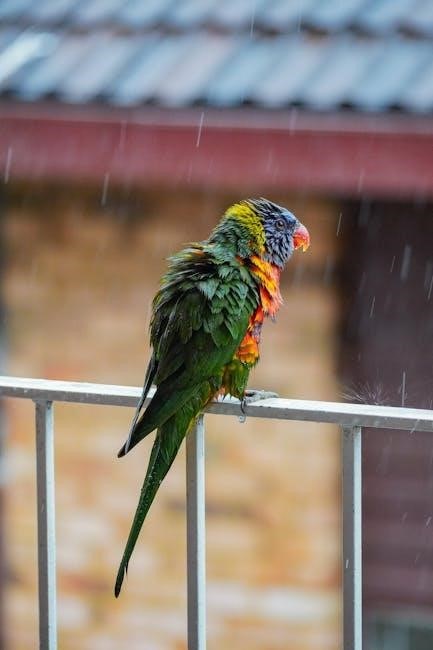The Rain Bird Rain Sensor is a reliable device that detects rain and automatically controls irrigation systems, promoting water conservation and efficiency. This manual provides comprehensive guidance on its installation, configuration, and maintenance to ensure optimal performance and extend its lifespan.
1.1 Overview of the Rain Bird Rain Sensor
The Rain Bird Rain Sensor is a water-saving device designed to detect rainfall and automatically shut off irrigation systems when precipitation is detected. It ensures efficient water use by preventing unnecessary watering during rain. Compatible with various Rain Bird controllers, this sensor offers adjustable sensitivity to customize its response to rainfall amounts. Its durable design withstands outdoor conditions, making it a reliable choice for residential and commercial irrigation systems. By integrating rain and freeze detection, it helps protect plants and conserve water effectively.
1.2 Importance of Using a Rain Sensor
Using a Rain Bird Rain Sensor is crucial for water conservation and efficient irrigation. It prevents overwatering by automatically shutting off the system during rain, reducing water waste and lowering bills. This device protects plants from excessive moisture, which can harm roots and promote disease. By integrating weather-based technology, it ensures irrigation only occurs when necessary, optimizing water use and maintaining healthy landscapes. Investing in a rain sensor enhances the efficiency of your irrigation system while supporting eco-friendly practices and reducing long-term maintenance costs.
1.3 Purpose of the Rain Bird Rain Sensor Manual
The Rain Bird Rain Sensor Manual serves as a detailed guide to help users understand, install, and maintain their rain sensor effectively. It provides step-by-step instructions for setup, configuration, and troubleshooting, ensuring optimal performance. The manual also offers insights into advanced features and best practices for water conservation. By following the manual, users can maximize the efficiency of their irrigation system, reduce water consumption, and extend the lifespan of the sensor. It is an essential resource for both new and experienced users seeking to make the most of their Rain Bird Rain Sensor.
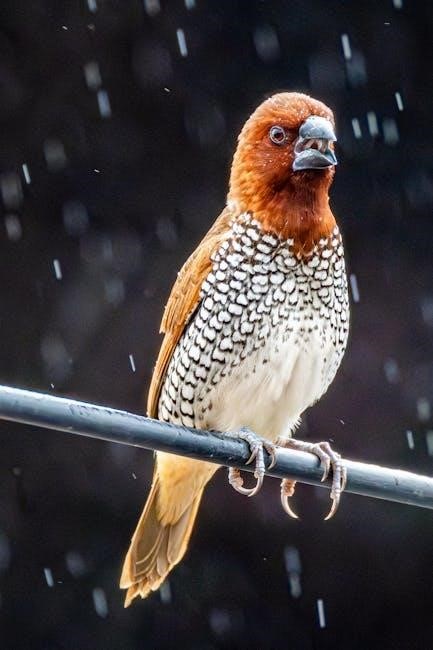
Installation of the Rain Bird Rain Sensor
This Rain Bird Rain Sensor installation is straightforward, requiring proper mounting, wiring, and positioning to ensure optimal performance. Follow the step-by-step guide for easy setup.
2.1 Mounting the Rain Bird Rain Sensor
Mount the Rain Bird Rain Sensor in an area exposed to direct rainfall, such as a north-facing eave or roof overhang, to ensure accurate moisture detection. Use the provided mounting hardware to secure the sensor firmly, ensuring it remains level and stable. Avoid placing the sensor near gutters or shaded areas, as this may lead to inconsistent readings. Proper mounting ensures the sensor accurately detects rainfall and effectively controls your irrigation system, promoting efficient water usage and system performance.
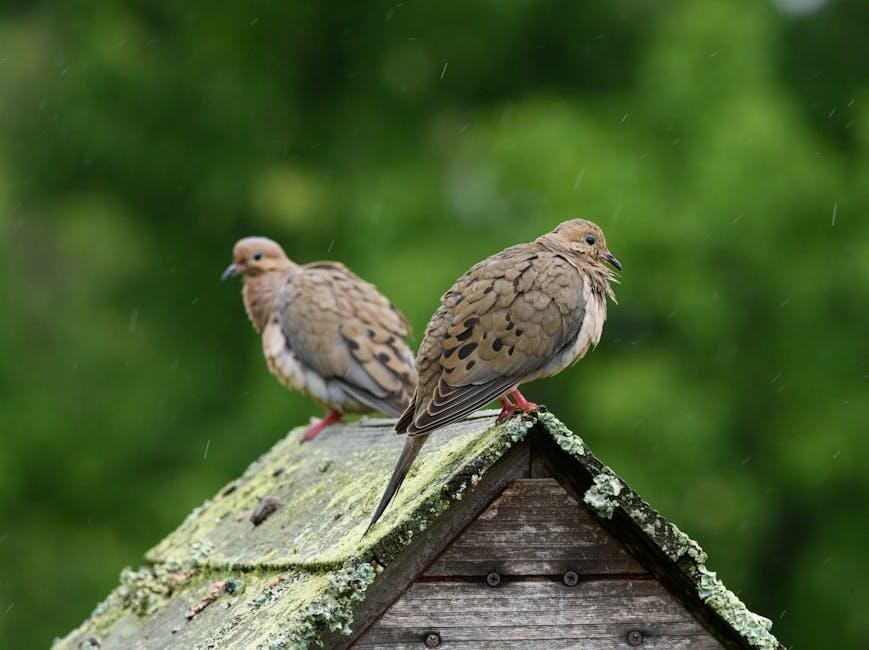
2.2 Wiring the Rain Bird Rain Sensor
Connect the Rain Bird Rain Sensor to your irrigation controller by attaching the sensor wire to the designated terminals. Ensure the wiring is securely fastened to prevent loose connections. For most Rain Bird controllers, the sensor connects to the “RAIN” or “SENSOR” terminal. Refer to your controller’s manual for specific terminal locations. Proper wiring ensures the sensor communicates effectively with the irrigation system, allowing it to pause watering during rain events. Always follow safety guidelines and turn off the power supply before making any wiring connections.
2.3 Positioning the Rain Bird Rain Sensor for Optimal Performance
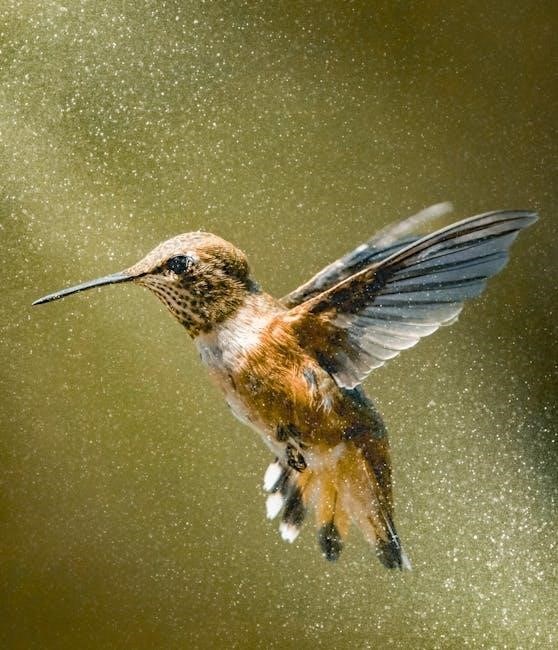
Mount the Rain Bird Rain Sensor in an open area exposed to natural rainfall, ensuring it accurately detects moisture. Install it at least 4 feet above the ground to avoid splashes from gutters or sprinklers. Avoid shaded or obstructed locations, as this may reduce its ability to sense rain effectively. Position the sensor away from downspouts and direct sunlight to prevent interference. Secure it firmly to prevent movement and ensure proper alignment with the irrigation controller. Proper placement ensures reliable operation and accurate water conservation.
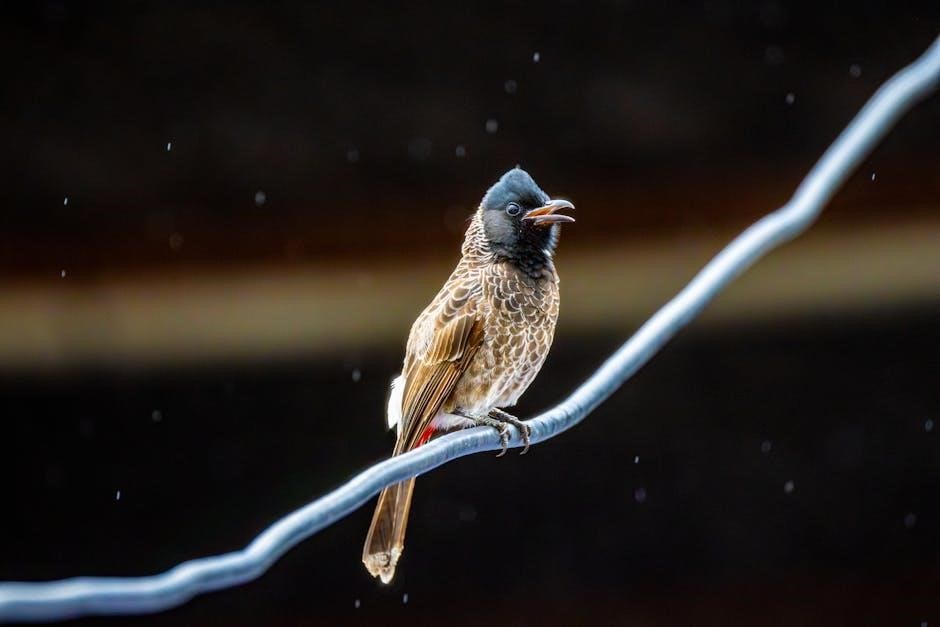
Configuration and Setup
The Rain Bird Rain Sensor is easy to configure, allowing users to set sensitivity, rain delay, and other preferences. Proper setup ensures efficient irrigation management and water conservation. The manual provides step-by-step guidance for programming and adjusting settings to meet specific needs, ensuring optimal performance and integration with your irrigation system.
3.1 Setting Up the Rain Bird Rain Sensor Sensitivity
Setting the sensitivity of the Rain Bird Rain Sensor ensures it accurately detects rainfall and activates the irrigation system accordingly. To adjust, locate the sensitivity dial on the sensor and rotate it clockwise for higher sensitivity or counterclockwise for lower sensitivity. The default setting typically works for most climates, but adjustments may be needed based on local conditions. For optimal performance, set the sensor to trigger after a quarter inch of rainfall. Testing the sensor by simulating rainfall can confirm proper function. Adjustments should be made gradually to avoid over or undersensitivity, ensuring efficient water use and system reliability.
3.2 Adjusting the Rain Delay Feature
The Rain Delay feature on the Rain Bird Rain Sensor allows you to temporarily pause irrigation after rain. To adjust, access the sensor’s settings menu and select the Rain Delay option. Choose the desired delay duration, typically ranging from 24 to 72 hours. This ensures the soil absorbs rainwater before resuming irrigation. After setting, the sensor will automatically restart the watering schedule once the delay period ends. Proper adjustment prevents overwatering and optimizes water conservation. Regularly review and update the delay setting based on seasonal weather patterns for maximum efficiency.
3.3 Testing the Rain Bird Rain Sensor
Testing the Rain Bird Rain Sensor ensures proper functionality. Start by simulating rain with water or a wet cloth to activate the sensor. Observe if the irrigation system pauses or shuts off. After testing, allow the sensor to dry fully to confirm it resumes normal operation. Regular testing helps verify sensitivity settings and confirms the sensor’s ability to detect moisture accurately. This step is crucial for preventing overwatering and ensuring the system operates as intended. Perform tests after installation and any adjustments to guarantee reliability.
Maintenance and Troubleshooting
Regular maintenance ensures the Rain Bird Rain Sensor operates effectively. Clean the sensor, inspect wiring, and troubleshoot common issues like faulty connections or debris buildup promptly.
4.1 Cleaning the Rain Bird Rain Sensor
Cleaning the Rain Bird Rain Sensor is essential for maintaining accuracy. Gently wipe the sensor surface with a soft, dry cloth to remove dirt, debris, or mineral buildup. Avoid using harsh chemicals or abrasive materials, as they may damage the sensor. For stubborn spots, dampen the cloth with distilled water, but ensure the sensor is dry before resuming operation. Regular cleaning prevents false readings and ensures the sensor accurately detects rainfall, optimizing your irrigation system’s performance and water conservation efforts.
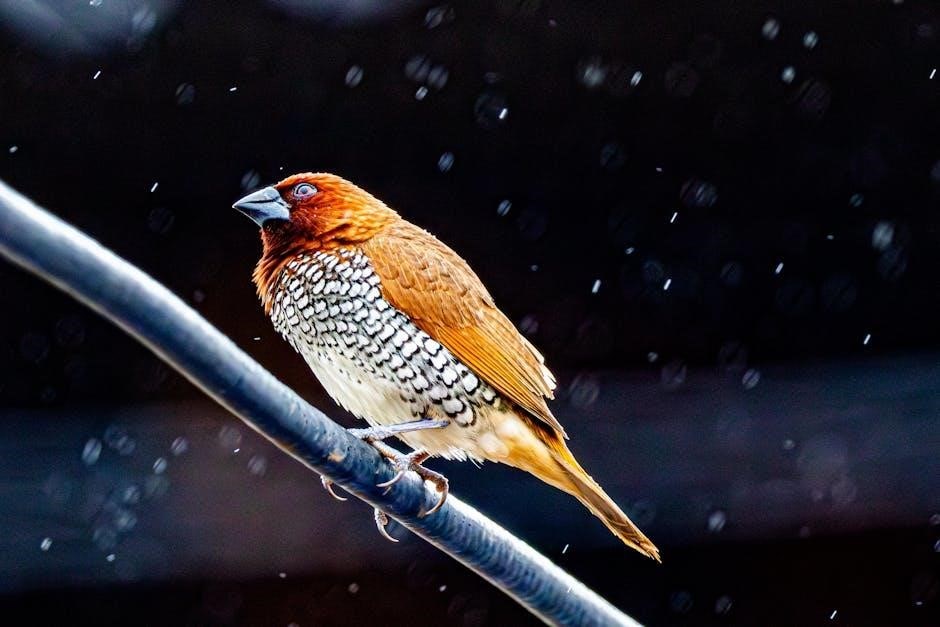
4.2 Checking and Replacing Worn-out Parts
Regularly inspect the Rain Bird Rain Sensor for worn-out components, such as corroded contacts or damaged wiring. Replace any faulty parts immediately to ensure proper function. Use genuine Rain Bird replacement parts to maintain reliability. For sensors with moving components, lubricate hinges or pivot points to prevent friction. If the sensor’s surface becomes scratched or faded, consider replacing it entirely. Always refer to the manual for specific part numbers and replacement procedures. Timely maintenance prevents malfunctions and ensures accurate rain detection, safeguarding your irrigation system’s efficiency and water-saving capabilities.
4.3 Common Issues and Solutions
Common issues with the Rain Bird Rain Sensor include failure to detect rain, inconsistent watering schedules, or sensor inactivity. Check for debris accumulation on the sensor surface, as dirt or leaves can block rain detection. Ensure proper wiring connections and verify sensor calibration. If the sensor fails to activate, inspect for corrosion or damage. Replace faulty components promptly using genuine Rain Bird parts. Resetting the system or recalibrating sensitivity may resolve operational issues. Regular maintenance and inspections help prevent these problems, ensuring the sensor functions accurately and reliably throughout the seasons.
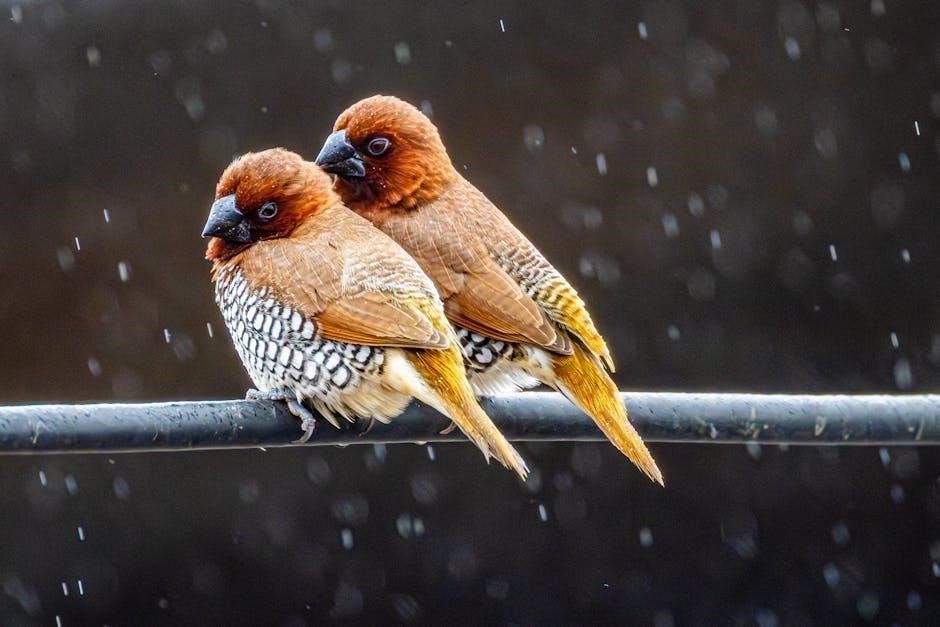
Advanced Features of the Rain Bird Rain Sensor
The Rain Bird Rain Sensor offers advanced features like smart irrigation integration, customizable watering schedules, and seasonal adjustments, ensuring efficient water management and tailored irrigation control.
5.1 Integrating with Smart Irrigation Systems
Integrating the Rain Bird Rain Sensor with smart irrigation systems enhances water management efficiency. It works seamlessly with controllers like the Rain Bird ESP-Me and IQ4, allowing real-time adjustments based on weather conditions. This integration enables remote monitoring and control via mobile apps, ensuring precise watering schedules. The sensor’s data syncs with the system to automatically pause irrigation during rain or freeze events, optimizing water usage. Advanced features like customizable watering cycles and seasonal adjustments further personalize irrigation control, promoting water conservation while maintaining landscape health.
5.2 Customizing Watering Schedules
Customizing watering schedules with the Rain Bird Rain Sensor ensures efficient irrigation tailored to your landscape’s needs. The sensor allows adjustments based on weather conditions, enabling precise control over watering cycles. Using the Seasonal Adjust feature, users can modify watering times throughout the year to match changing weather patterns. This feature adjusts irrigation schedules dynamically, reducing water usage during cooler or wetter periods. By integrating with smart controllers like the ESP-Me or IQ4, users can set specific days, times, and durations for each zone, ensuring optimal water conservation while maintaining plant health.
5.3 Using the Seasonal Adjust Feature
The Seasonal Adjust feature allows users to fine-tune watering schedules based on changing weather conditions and plant needs throughout the year. By adjusting a percentage-based scale, the system modifies watering durations accordingly. For example, reducing the percentage during cooler months or increasing it in hotter periods ensures plants receive the right amount of water. This feature is compatible with Rain Bird controllers like the ESP-Me and IQ4, offering flexibility and efficiency. Regularly updating the Seasonal Adjust settings helps maintain optimal watering schedules and promotes water conservation.
Water Conservation Tips
Optimize water usage with the Rain Bird Rain Sensor by utilizing features like rain delay and seasonal adjustments. These tools help reduce waste and promote efficient irrigation practices.
6.1 Optimizing Water Usage with the Rain Bird Rain Sensor
Optimizing water usage with the Rain Bird Rain Sensor involves leveraging its advanced features like rain delay and seasonal adjustments. These settings ensure irrigation occurs only when necessary, preventing overwatering. By detecting rain and freezing conditions, the sensor automatically pauses watering, conserving water and energy. Additionally, customizing watering schedules based on weather conditions further enhances efficiency. This not only reduces water bills but also supports environmental sustainability. Regular maintenance and proper installation are key to maximizing these benefits, ensuring your irrigation system operates effectively and responsibly.
6.2 Understanding Watering Cycles
Watering cycles refer to the frequency and duration of irrigation sessions controlled by the Rain Bird system. Understanding these cycles is crucial for efficient water use. The sensor helps customize cycles based on weather conditions and soil moisture levels. By adjusting start times, intervals, and run times, you can ensure plants receive the right amount of water without overwatering. This feature, combined with the rain sensor’s automatic pauses during rainfall, optimizes water usage and promotes healthier plant growth. Properly configured cycles also reduce runoff and deep drainage, making irrigation more effective and environmentally friendly.
6.3 Adjusting Watering Times Based on Weather Conditions
Adjusting watering times according to weather conditions ensures optimal irrigation efficiency. The Rain Bird Rain Sensor allows real-time modifications, pausing irrigation during rain and resuming when conditions change. Use the Seasonal Adjust feature to increase or decrease watering times based on temperature and precipitation forecasts. This customization prevents overwatering during cooler periods and ensures adequate hydration during hot spells. By syncing watering schedules with weather patterns, you conserve water and reduce waste, while promoting healthy plant growth and lowering utility bills.
Safety and Security Features
The Rain Bird Rain Sensor includes freeze protection, fail-safe mode, and emergency shutoff, ensuring safe operation and preventing damage from extreme weather conditions and system malfunctions.
7.1 Freeze Protection with the Rain Bird Rain Sensor
The Rain Bird Rain Sensor offers advanced freeze protection, automatically deactivating the irrigation system during low temperatures to prevent damage from freezing. This feature ensures that pipes and sprinklers remain intact, avoiding costly repairs. The sensor detects temperature drops and halts watering cycles until conditions improve. It also maintains battery life in cold weather, ensuring continuous protection. Proper installation in a shaded area can enhance its accuracy. This feature is essential for regions with harsh winters, providing peace of mind and safeguarding your irrigation system year-round.
7.2 Fail-Safe Mode and Emergency Shutoff
The Rain Bird Rain Sensor features a fail-safe mode that ensures your irrigation system shuts off during extreme weather conditions or system malfunctions. This prevents water waste and protects your lawn. The emergency shutoff option allows manual override, stopping irrigation immediately if needed. These features work together to safeguard your system, ensuring efficient water use and preventing potential damage. They are especially useful in unpredictable weather conditions, providing an added layer of security for your irrigation setup.
7.3 Ensuring Safe Installation and Operation
Safety is crucial when installing and operating the Rain Bird Rain Sensor. Follow all manufacturer guidelines to avoid electrical hazards or system damage. Ensure the sensor is mounted securely and wiring is properly connected to prevent short circuits. Regularly inspect the device for damage or wear. Always test the sensor after installation to confirm it functions correctly. Adhere to local safety standards and best practices for irrigation systems. Proper installation and maintenance ensure reliable performance and prevent potential issues, safeguarding both your system and the environment.
Technical Specifications
The Rain Bird Rain Sensor is compatible with various controllers, operates on low power, and withstands environmental conditions. It ensures accurate rain detection and reliable performance.
8.1 Compatibility with Rain Bird Controllers
The Rain Bird Rain Sensor is designed to seamlessly integrate with a variety of Rain Bird irrigation controllers, including the ESP-Me and ESP-TM2 models. This compatibility ensures easy installation and operation, allowing users to enhance their irrigation system’s efficiency. The sensor works in tandem with these controllers to detect rainfall and automatically adjust watering schedules, preventing unnecessary water usage. Its universal design supports multiple controller types, making it a versatile solution for both residential and commercial irrigation systems. This integration ensures optimal performance and water conservation.
8.2 Power Requirements and Battery Life
The Rain Bird Rain Sensor operates on a low-power requirement, typically using a 2.5 to 3-volt lithium battery. It is designed for energy efficiency, ensuring long battery life, often lasting up to 5 years under normal conditions. The sensor’s battery compartment is easily accessible for replacement, and it includes a low-battery indicator to alert users when a change is needed. This feature ensures uninterrupted operation and maintains the sensor’s reliability in conserving water and managing irrigation systems effectively over time.
8.3 Environmental Operating Range
The Rain Bird Rain Sensor is designed to function effectively in various environmental conditions. It operates within a temperature range of -20°C to 60°C (-4°F to 140°F) and can withstand humidity levels up to 90%. The sensor is built to resist dust and water ingress, with an IP66 rating, ensuring durability in outdoor settings. Proper placement, avoiding direct sunlight and extreme weather exposure, is recommended for optimal performance. This robust design ensures reliable rain detection and irrigation control across diverse climates and weather conditions, making it a versatile solution for water conservation efforts.
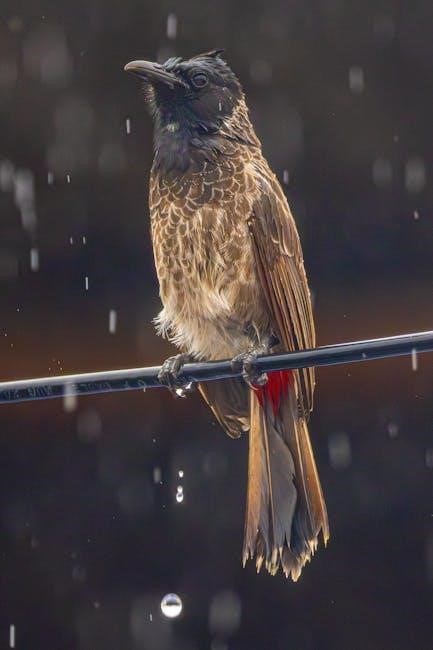
Programming the Rain Bird Rain Sensor
Programming the Rain Bird Rain Sensor allows you to customize irrigation schedules, set rain delays, and adjust sensitivity for efficient water management. It ensures tailored watering cycles based on weather conditions and seasonal changes, optimizing water usage while maintaining lawn health. The sensor integrates seamlessly with compatible controllers, offering flexible programming options to suit various landscaping needs and preferences. This feature-rich system promotes water conservation and adapts to different environmental conditions effortlessly.
9.1 Setting Up the Initial Program
Setting up the initial program for the Rain Bird Rain Sensor involves configuring the controller with your preferred watering schedule. Start by setting the current time and date, then select the days you want the irrigation system to operate. Choose the watering duration for each zone and adjust the start times to ensure even water distribution. Use the Seasonal Adjust feature to customize watering times based on weather conditions. Save your settings and test the program to ensure it operates correctly. This initial setup ensures efficient water use and maintains optimal lawn health year-round.
9.2 Adjusting Programs for Different Seasons
Adjusting programs for different seasons ensures your irrigation system adapts to changing weather conditions. Use the Seasonal Adjust feature to increase or decrease watering times by a percentage (5-200%). For cooler months, reduce watering duration to prevent overwatering. In warmer seasons, increase it to maintain healthy vegetation. Access the menu, select the adjustment percentage, and apply it to all zones or specific ones. This feature allows for efficient water use and maintains optimal lawn health throughout the year. Regularly monitor and adjust settings based on local climate variations for best results.
9.3 Manual Override and Temporary Adjustments
The Rain Bird Rain Sensor allows for manual overrides and temporary adjustments, enabling users to bypass automatic settings when needed. This feature is useful during unexpected weather changes or for testing. To access manual mode, navigate to the controller’s menu and select the desired zone or program. Adjust watering times or disable certain zones as required. Temporary adjustments can also be made using the Rain Delay feature, which pauses irrigation for a set period. Always test changes to ensure proper system function and adjust settings back to automatic when conditions stabilize.
Energy Efficiency and Cost Savings
The Rain Bird Rain Sensor enhances energy efficiency by preventing unnecessary watering during rain, reducing water and energy consumption. This leads to lower utility bills and environmental benefits.
10.1 Reducing Energy Consumption
The Rain Bird Rain Sensor significantly reduces energy consumption by automatically shutting off irrigation systems during rainfall, eliminating unnecessary water usage. This feature not only conserves energy but also lowers water bills and extends the lifespan of your irrigation system. By preventing overwatering, it optimizes watering schedules based on weather conditions, ensuring your lawn receives only the water it needs. This eco-friendly solution supports energy efficiency and contributes to long-term cost savings, making it a practical choice for environmentally conscious homeowners.
10.2 Lowering Water Bills
The Rain Bird Rain Sensor helps significantly lower water bills by preventing unnecessary irrigation during rainfall. Its advanced detection system automatically shuts off the sprinklers when rain is detected, ensuring water is used only when needed. This feature reduces overwatering and optimizes watering cycles, leading to substantial savings on water costs. By customizing watering schedules based on weather conditions, the sensor eliminates waste and ensures efficient water usage, making it an essential tool for homeowners aiming to reduce their water bills while maintaining a healthy lawn.
10.3 Long-term Benefits of Using the Rain Bird Rain Sensor
The Rain Bird Rain Sensor offers long-term benefits by conserving water and protecting landscaping. It prevents overwatering, which can harm plants and waste resources. Over time, it reduces soil erosion and extends the lifespan of the irrigation system. By optimizing water usage, it aligns with eco-friendly practices, making it a sustainable choice. Regular use ensures consistent lawn health and reduces maintenance needs, providing a cost-effective solution for homeowners. Its durability and reliability make it a valuable investment for efficient and responsible irrigation management.
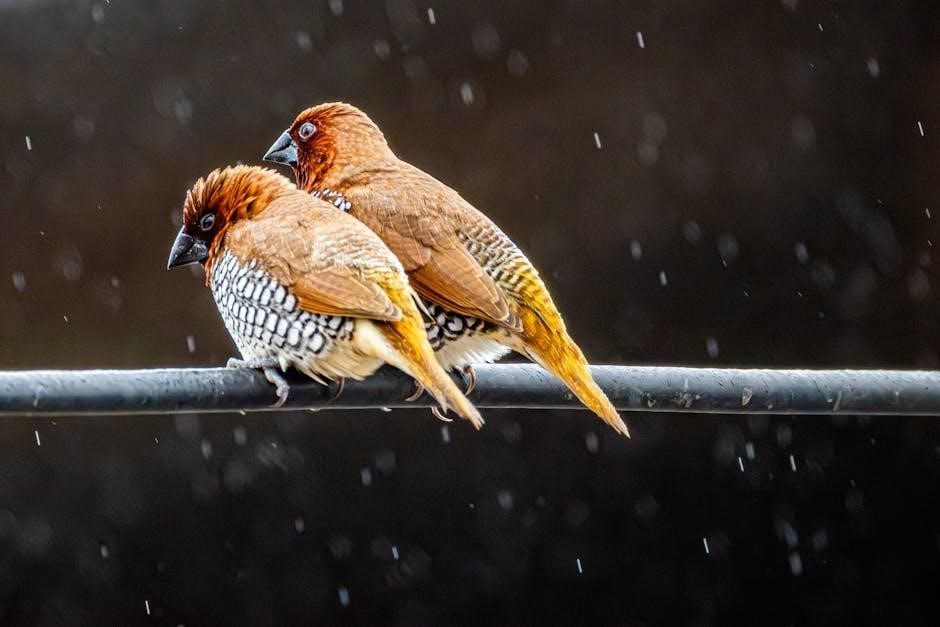
Frequently Asked Questions
This section addresses common queries about the Rain Bird Rain Sensor, including troubleshooting, installation, programming, and water-saving tips, helping users optimize their irrigation system effectively.
11.1 General Inquiries About the Rain Bird Rain Sensor
Users often ask how the Rain Bird Rain Sensor works, its compatibility with different controllers, and its role in water conservation. It detects rain to prevent overwatering, integrating with systems like the ESP-TM2. Questions also arise about its wireless capabilities, sensitivity adjustments, and how it interacts with smart irrigation systems. Many inquire about its durability, power requirements, and whether it can detect freezing temperatures. This section provides clear answers to these common questions, helping users understand the sensor’s functionality and benefits for efficient irrigation management.
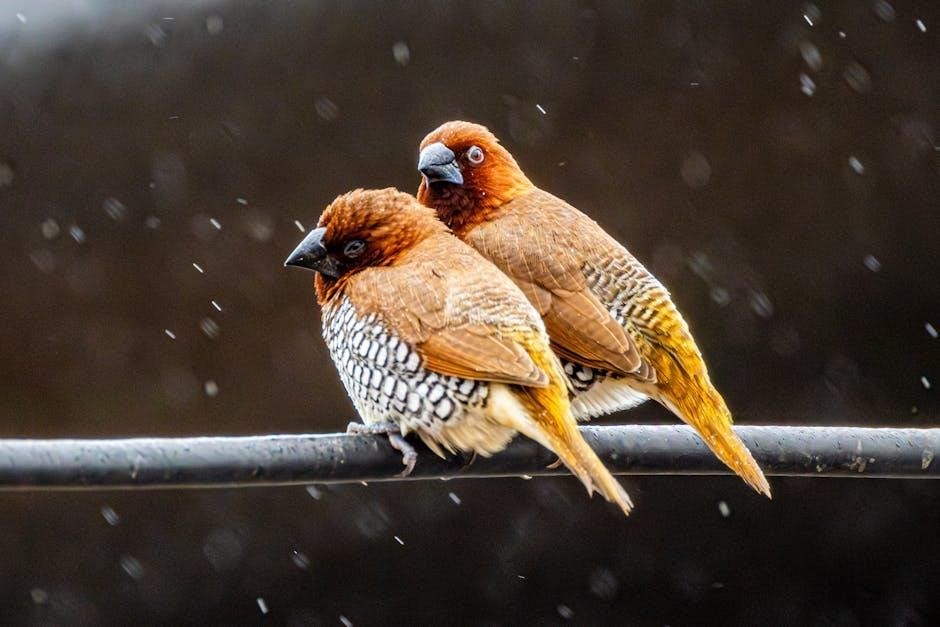
11.2 Common Misconceptions
Some users believe the Rain Bird Rain Sensor is overly complex to install or requires frequent adjustments. Others think it only works with specific controllers. However, it is compatible with most Rain Bird systems, including the ESP-TM2 and WR2 models. Another myth is that the sensor cannot detect freezing temperatures, but it actually offers freeze protection. Many assume it requires constant manual overrides, yet it operates automatically once configured. These misconceptions often stem from a lack of familiarity, but the sensor is designed to be user-friendly and efficient for various irrigation needs.
11.3 Troubleshooting FAQs
Why isn’t my Rain Bird Rain Sensor working? Check if it’s properly mounted and wired. Ensure sensitivity settings are adjusted correctly. If the screen shows “off,” reset the system or replace the battery. Some users ask, “Why is water running despite rain?” This could be due to a faulty solenoid or incorrect wiring. Another common query: “How do I manually override the sensor?” Use the manual station feature or adjust settings via the controller. Always refer to the manual for specific troubleshooting steps to resolve issues efficiently.
The Rain Bird Rain Sensor enhances irrigation efficiency, promotes water conservation, and ensures optimal lawn care. Regular maintenance and proper setup are key to its long-term performance.
12.1 Summary of Key Features
The Rain Bird Rain Sensor is an essential component for efficient irrigation systems, designed to prevent unnecessary watering during rain or freezing conditions. It offers adjustable sensitivity to customize water conservation efforts and includes a rain delay feature to pause irrigation temporarily. The sensor integrates seamlessly with smart irrigation systems, allowing for advanced customization of watering schedules and seasonal adjustments. Its durable design ensures long-term performance, while the fail-safe mode provides added security. Regular maintenance, such as cleaning and checking parts, ensures optimal functionality, making it a reliable solution for water-efficient lawn care.
12.2 Final Tips for Effective Use
For optimal performance, ensure the sensor is installed in an area exposed to natural rainfall and free from obstructions. Adjust sensitivity based on local weather patterns to avoid overwatering. Regularly clean the sensor to maintain accuracy and reliability. Use the rain delay feature wisely to conserve water during wet conditions. Always refer to the manual for troubleshooting common issues. By following these tips, you can maximize water efficiency, protect your landscape, and extend the lifespan of your Rain Bird Rain Sensor.
12.3 Importance of Regular Maintenance
Regular maintenance is crucial to ensure the Rain Bird Rain Sensor operates efficiently and accurately. Cleaning the sensor periodically prevents debris buildup, which could interfere with rain detection. Checking and replacing worn-out parts, such as the battery or wiring, ensures uninterrupted functionality. Proper upkeep also prevents false readings, which could lead to overwatering or system malfunctions. By maintaining your sensor, you extend its lifespan, optimize water usage, and ensure your irrigation system performs reliably year-round. Regular checks are essential for consistent performance and long-term cost savings.
